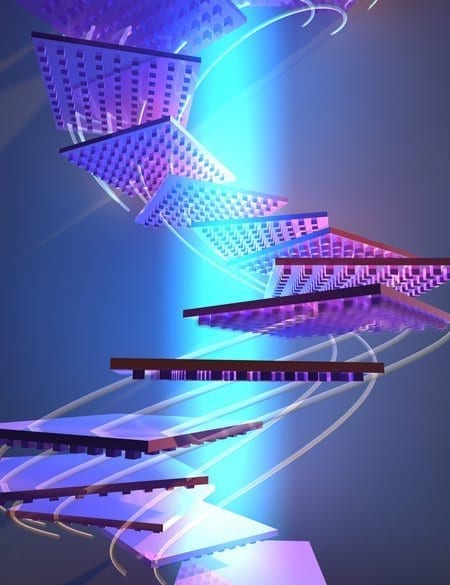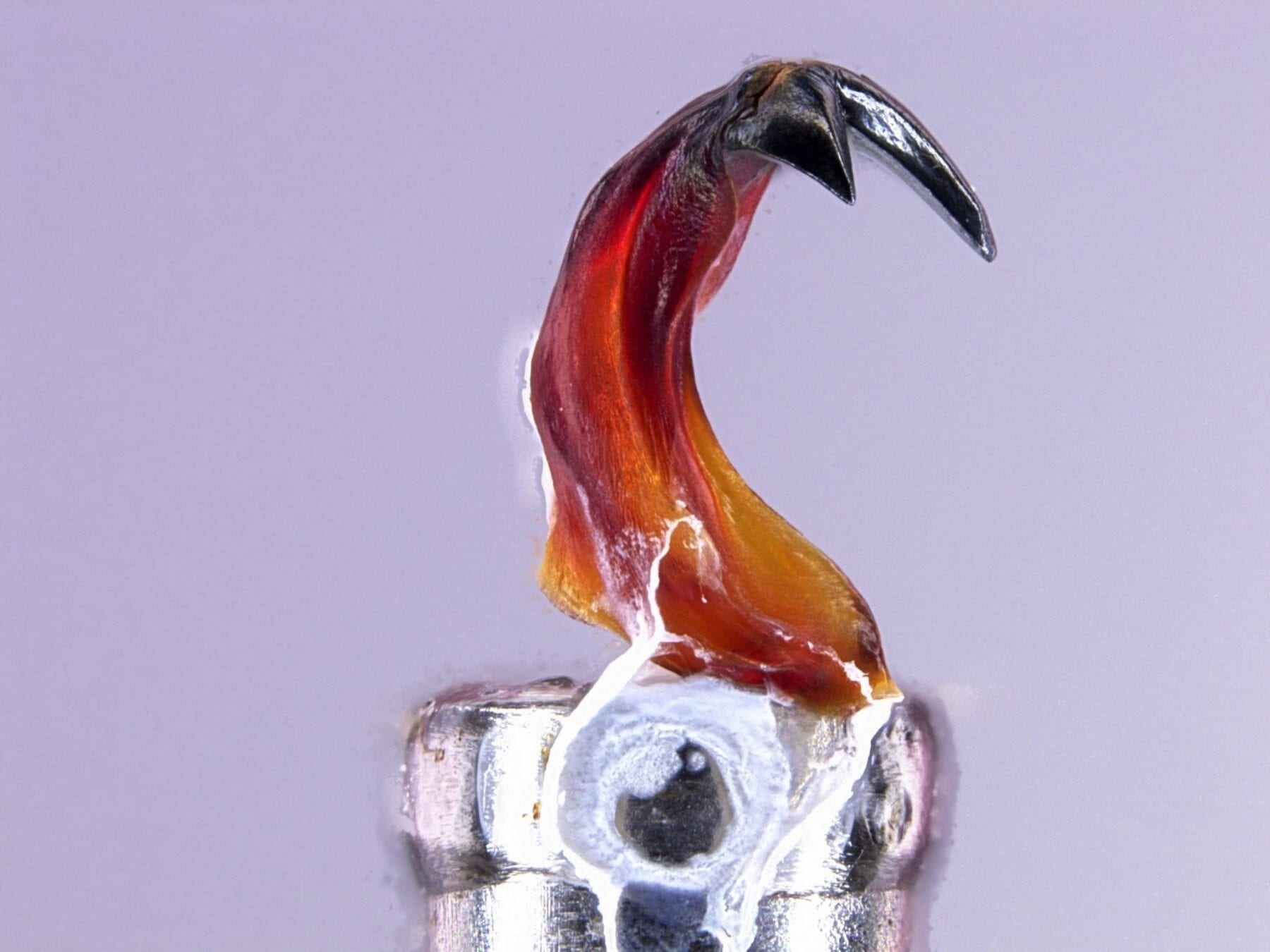
Credit: Courtesy of the Atwater laboratory
Nanoscale patterning could enable precise manipulation of objects on many scales.
Researchers at Caltech have designed a way to levitate and propel objects using only light, by creating specific nanoscale patterning on the objects’ surfaces.
Though still theoretical, the work is a step toward developing a spacecraft that could reach the nearest planet outside of our solar system in 20 years, powered and accelerated only by light.
A paper describing the research appears online in the March 18 issue of the journal Nature Photonics. The research was done in the laboratory of Harry Atwater, Howard Hughes Professor of Applied Physics and Materials Science in Caltech’s Division of Engineering and Applied Science.
Decades ago, the development of so-called optical tweezers enabled scientists to move and manipulate tiny objects, like nanoparticles, using the radiative pressure from a sharply focused beam of laser light. This work formed the basis for the 2018 Nobel Prize in Physics. However, optical tweezers are only able to manipulate very small objects and only at very short distances.
Ognjen Ilic, postdoctoral scholar and the study’s first author, gives an analogy: “One can levitate a ping pong ball using a steady stream of air from a hair dryer. But it wouldn’t work if the ping pong ball were too big, or if it were too far away from the hair dryer, and so on.”
With this new research, objects of many different shapes and sizes—from micrometers to meters—could be manipulated with a light beam. The key is to create specific nanoscale patterns on an object’s surface. This patterning interacts with light in such a way that the object can right itself when perturbed, creating a restoring torque to keep it in the light beam. Thus, rather than requiring highly focused laser beams, the objects’ patterning is designed to “encode” their own stability. The light source can also be millions of miles away.
“We have come up with a method that could levitate macroscopic objects,” says Atwater, who is also the director of the Joint Center for Artificial Photosynthesis. “There is an audaciously interesting application to use this technique as a means for propulsion of a new generation of spacecraft. We’re a long way from actually doing that, but we are in the process of testing out the principles.”
In theory, this spacecraft could be patterned with nanoscale structures and accelerated by an Earth-based laser light. Without needing to carry fuel, the spacecraft could reach very high, even relativistic speeds and possibly travel to other stars.
Atwater also envisions that the technology could be used here on Earth to enable rapid manufacturing of ever-smaller objects, like circuit boards.
Learn more: Levitating Objects with Light
The Latest on: Nanoscale patterning
[google_news title=”” keyword=”nanoscale patterning” num_posts=”10″ blurb_length=”0″ show_thumb=”left”]
via Google News
The Latest on: Nanoscale patterning
- Cubic millimetre of brain mapped in spectacular detailon May 8, 2024 at 5:00 pm
Google scientists have modelled a fragment of the human brain at nanoscale resolution, revealing cells with previously undiscovered features.
- Capillary Force Lithography (CFL): Patterning Surfaces at the Nanoscaleon May 2, 2024 at 9:01 pm
What is Capillary Force Lithography? Capillary Force Lithography (CFL) is a versatile and cost-effective technique for patterning surfaces at the nanoscale. It leverages the capillary forces arising ...
- New method to measure entropy production on the nanoscaleon March 26, 2024 at 6:42 am
Extending thermodynamics for ultrashort excitations will provide novel insights into how materials function on the nanoscale," says ... atoms arrange in repeating patterns. Laser light can shake ...
- Block Copolymer Lithography: Patterning at the Nanoscaleon March 17, 2024 at 10:52 am
Upper row: schematic process flow, scanning electron microscope (SEM) images of resulting patterns. (Image: Fraunhofer Society) Block copolymer lithography has been explored for the fabrication of ...
- Health: Bots and the beautifulon January 8, 2024 at 3:30 am
Imprint Reprint Engineer David Gracias of Johns Hopkins University recently developed a nano-imprint lithography technique that allows for gold tattooing on living tissue—basically using a stamp to ...
- Irma Kuljanishvili, Ph.D.on June 15, 2023 at 4:31 am
Synthesis and characterization of novel 1D and 2D nanoscale materials for scalable device technologies and applications Scanning Probe Microscopy and Spectroscopy techniques SPM based lithography; ...
- Kate Queeneyon May 28, 2022 at 3:48 am
Kate Queeney is a physical chemist who specializes in the chemistry that takes place on solid surfaces. Her lab is exploring the combined effects of surface chemistry and surface nanotopography on the ...
- Using Lasers to Create Super-Hydrophobic Metals (VIDEO)on May 25, 2022 at 3:03 pm
describe a powerful and precise laser-patterning technique that creates an intricate pattern of micro- and nanoscale structures to give the metals their new properties.
- Zeroing in on the Elusive Green LED (2 of 2) (IMAGE)on May 22, 2022 at 11:57 am
Led by Professor Christian Wetzel, the research team etched a nanoscale pattern at the interface between the LED’s sapphire base and the layer of gallium nitride (GaN) that gives the LED its ...
- Research Centerson May 19, 2022 at 7:54 am
As applications grow beyond microelectronics, new needs for research into nanoscale patterning and materials emerge. The Nanolithography Research Laboratories at RIT has pioneered key advances in ...
via Bing News










